12 Killer Blues Licks You Must Know
You can drop any of these 12 classic phrases into a blues-based progression and come out smiling.

Yes, many blues and rock licks are cliches, but there’s a good reason for that – they sound so cool that listeners and guitarists want to hear and play them again and again.
For those willing to pay their dues and play the blues, these licks are a rite of passage and a continuous source of inspiration. They are the foundation on which a solid house of blues is built.
Presented here for your edification are 12 classic blues guitar phrases, each with a certified pedigree. You can drop any of these into a blues-based progression and come out smiling. Or you can play them in sequence over a standard 12-bar blues to create one very hip solo, as we’ll do for the very last step of this lesson.
Before we dive in, let’s take a look at three blues scale patterns that form the basis of our 12 licks. A quick run through these shapes will help wake up our hands and minds.

The first pattern, Figure 1, is a full-blown A blues scale in 5th position. Notice that it contains the root, b3rd, 4th, b5th, 5th, and b7th degrees of an A major scale. All of the licks that we’ll look at here will be presented in the context of an A major blues.
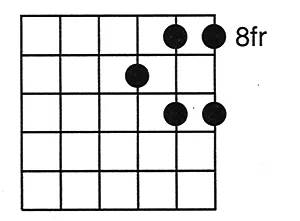
The second pattern, Figure 2, is a reduced version of this same scale, which includes only the root, b3rd, 4th, 5th, and b7th. This compact shape, known colloquially as the “Albert King Box” – because King virtually lived there after he signed with Stax/Volt Records in 1966 – is an especially finger-friendly position.

The third pattern, Figure 3, commonly called the “B.B. King Box” (because he spent so much time there from the Sixties onward), contains the same scale degrees as the previous box but covers more of the fingerboard.
Now, with fingers poised and minds focused, let’s begin our journey from Mississippi to Texas, with pertinent stops in Chicago, Memphis, and New Orleans.

Our first lick, Figure 4, is a striking opening phrase to be played over a I chord. T-Bone Walker showcased similar hot licks in his "Description Blues" and "Alimony Blues."
The bends to the b5th (Eb) and the true blue note (between C and C#) establish a solid blues tonality. Resolving to the root (A) of the I chord allows us the opportunity to follow with a lick that can chart an entirely new course, which is exactly what we see next.
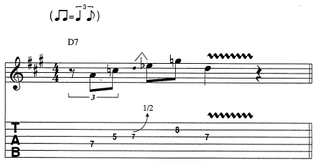
B.B. King employed a lick like the one shown in Figure 5 in his track "Sweet Little Angel" from Live at the Regal. The bends to the b5th (Eb) and the b7th (G) tantalize our auditory nerves before resolving smoothly to the 4th (D), which is the root of the IV chord.
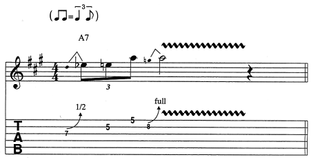
Any listing of the great blues guitar licks would have to include its fair share of B.B. King-isms, and this one is no exception. Figure 6 is the classic I chord lick, popularized by B.B. on countless tunes, including "Please Love Me," and appropriated globally by blues merchants everywhere.
The bend of the b7th (G) to the root (A) should be executed with the pinkie, backed up by the ring, middle, and index fingers. Accurate intonation and a steady wide vibrato are paramount to make this bad boy sing.
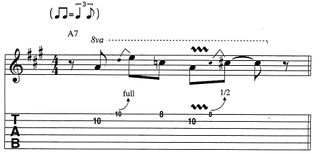
Figure 7 is the classic Albert King lick. Prominently displayed in "Crosscut Saw" and "Born Under a Bad Sign," it hovers and swoops like bird of prey. Start with your ring finger, using it for the full-step bend and the repeat of the root (A). Use your index finger for the b3rd (C) and the bend and vibrato'd major 3rd (C#).
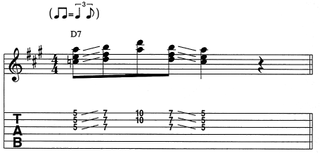
Breaking free momentarily from the tyranny of the scale, Figure 8 purveys a sliding IV6-to-IV9 chord pattern beloved by the likes of Johnny Moore (who played with Charles Brown in the 1940s) and T-Bone Walker. This particular example, with a root-4th (A–D) dyad thrown in, was used by the underrated Lonnie Mack in "Down and Out." Perform the slide with your index finger, nicking the dyad with your pinkie.

Considered by many to be the first electric guitar hero, Mike Bloomfield favored tangy bends like the one shown in Figure 9 in "Don’t Throw Your Love on Me So Strong" and "I’ve Got a Mind to Give Up Living."
Bend the b7th (G) of the scale to the root (A) with your ring finger, and hold the bend while you add in the b3rd (C) with your pinkie. The resulting dyad (A–C) provides the 5th and b7th of the IV chord, reinforcing its bluesy, dominant 7th flavor.
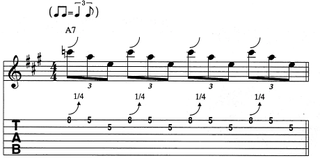
B.B. King had been heard tweaking up the tension in his solos with this slippery triplet pattern, shown in Figure 10. The quarter-note bend that begins each beat imparts an elastic feel that is quite captivating. B.B. played this one on "Three O’Clock Blues," and it's entirely possible that Eric Clapton learned it from that breakthrough hit.
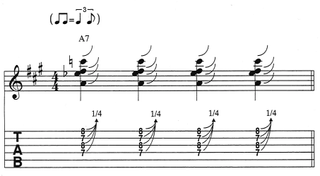
The mighty T-Bone cut heads in tunes like "Strolling with Bones" with this powerful diminished chord voicing, shown in Figure 11. Dig that the root (A), b5th (Eb), and b3rd (C) are right out of the A blues scale, while the 6th (F#) hints at the A Mixolydian mode. Low to high, use your index, ring, middle, and pinkie fingers on this chord, and don’t ignore that quarter-step bend.

B.B. flashed a similar climactic lick to this one (Figure 12) in King of Guitar. Start with your index finger, switching to your ring finger for the full-step bend of the 5th (E) to the 6th (F#).
Walk down the chromatic run (E-Eb-D) with your ring, middle, and index fingers. Articulate the half-step bend with your ring finger. Note the use of Eb as a passing tone between E and D, and the half-step bend from the B to C – neither of these twists belongs to the A blues scale.

B.B. steps up to the plate once more with this lick (Figure 13) in a King’s Special vein. Bend up to the 3rd (C#) with your ring finger, holding it while you play the 5th (E) with your pinkie. Vibrato the root (A) with your index finger like a hummingbird.
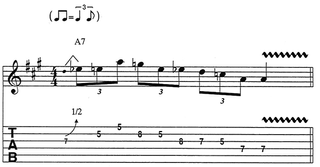
Freddie King continues this run (Figure 14) much like the ones to be found in "Torn Down." The use of the b5th (Eb) – played straight on rather than bent up to – is more characteristic of jazz than blues, but the pattern makes for a dandy turnaround lick over the I chord when you want to maintain a scalar approach.
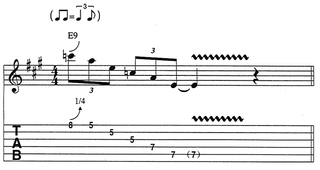
This last lick (Figure 15), probably has its roots in the work of B.B. King, but credit Jimi Hendrix and his version of "Red House" with securing it a spot in the Blues Hall of Fame.
Make sure that you barre fret 5 with your index finger after the blue note bend at fret 8. Use one continuous upstroke to zip down the run to the 5th (E). Play the root (A) with your ring finger, crossing over it with your middle finger to access the 5th.

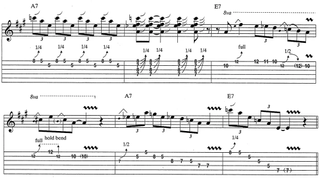
Figure 16 presents a very straightforward take on our 12 licks. We’re simply playing them in a row, as presented, with a few slight modifications in rhythm. Try doing the same yourself.
Remember all of these licks can be moved up or down the fretboard, which means that you can fit them into just about any key. So find a lick or two that you like and practice it up and down the neck.
Get The Pick Newsletter
All the latest guitar news, interviews, lessons, reviews, deals and more, direct to your inbox!
Most Popular

